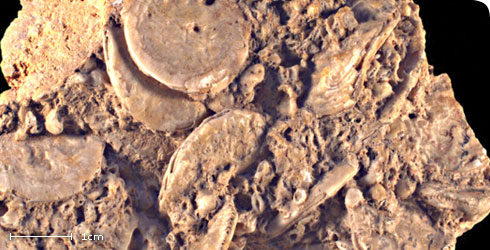Taxonomy
The micropalaeontologist is concerned with the abandoned, dead shells of foraminifera and classification of fossils species proceeds entirely on the basis of the morphology of the hard shell (test). In the case of all ‘Larger’ foraminifera, this involves detailed study of the internal chamber arrangement, especially of the initial chambers and is accomplished by splitting, or by making wafer-thin sections of specimens (see fig.3). More commonly, the host rock itself is thin-sectioned to reveal the fossils therein.
Morphology
Large, flattened disc with complex internal structure.
Diagnostic description
There are literally dozens of species of the genus Nummulites. Distinguishing species them involves the differentiation of finer detail of the characteristics of the genus and is a job for expert eyes and a microscope.
Lookalikes
From the outside many ‘Larger’ foraminifera look very similar and need to be thin-sectioned to reveal their diagnostic features.
Evolution
Nummulites evolved, along with a number of other ‘Larger’ foraminifera from one or more Cretaceous (which ended 65Ma) ancestors. The genus Nummulites ranged from late Middle Palaeocene epoch (about 60Ma) to near the end of the Oligocene epoch (around 25Ma) and the species N. gizehensis lived during the Middle Eocene (48Ma - 37Ma).
